Comments / Questions (85)
![]() Mieke wrote:
Mieke wrote:
Vrij meteen in het begin, snap ik niet goed hoe de minderingen gaan. Er staat: Minder op de laatste toer in telpatroon A1 tot en met A3 32 stk gelijkmatig voor alle maten. Moet ik in 1 toer al die 32 steken minderen ?? Normaal minder je verdeeld over een aantal toeren, misschien is dat i.v.m. het patroon niet mogelijk, maar het lijkt me nogal veel in 1 toer., of lees ik het verkeerd?
29.05.2016 - 20:47DROPS Design answered:
Hoi Mieke. Ja, je mindert gelijkmatig 32 st in die ene toer over de st van A.1, 2 en 3
30.05.2016 - 13:23
![]() Shannon wrote:
Shannon wrote:
Ik ben nu nog met het middelste gedeelte van dit vest bezig. Maar ik ben bijna bij het voor en achterpand. Nu snap ik alleen niet of ik die los moet haken of gewoon gelijk op de laatste toer en dan alleen vastmaken als ik de 2 voorpanden en achterpand klaar heb🙈
14.05.2016 - 19:04DROPS Design answered:
Hoi Shannon. Je hebt de voorpanden en achterpand in één gehaakt tot aan de armsgaten. Hier deel je het werk in voorpanden en achterpand en haakt nu elke deel afzonderlijk verder. Bij het afwerken sluit je de schoudernaden.
17.05.2016 - 13:40
![]() Kiki Clauer wrote:
Kiki Clauer wrote:
Auf die idee bin ich natürlich nicht gekommen,. Vielen dank für eure hilfe
03.05.2016 - 10:37Ivar wrote:
Ich glaube es ist keine Masche sondern ein Pfeil und bedeutet: es wird in diese Masche gehäkelt"
20.04.2016 - 15:28
![]() Kiki wrote:
Kiki wrote:
Hallo nochmal, Vielen Danke für den tipp. Ich hab mich jetzt mal durch so ähnliche muster durchprobiert nur finde ich nirgends eine antwort auf meine frage : welche masche ist in a.1 bis a.3 in reihe 3 gemeint ? Ich finde keine erklärung zu dem diagramm. Kann mir jemand bitte die masche sagen (feste masche, doppelstäbchen .... ??) Oder wo finde ich im raum bodensee jemanden der mir weiterhelfen kann ? Danke für eure hilfe
20.04.2016 - 13:41DROPS Design answered:
Liebe Kiki, Sie finden alle Symbole in der Legende erklärt. Der Pfeil zwischen Reihe 2 und 3 zeigt, in welche Masche die 2 Dreifach-Stb gehäkelt werden.
21.04.2016 - 08:33
![]() Kiki wrote:
Kiki wrote:
Hallo zusammen, Ich versuche mich zum ersten mal am häkeln. Leider komme ich mit der maschenschrift leider nicht ganz klar. A1 -A3 3. Reihe was muss ich da häkeln ?? Gibt es auch ein video von diesem muster ? Für ihre mühe möchte ich mich schon im voraus bedanken Liebe grüße kiki
18.04.2016 - 21:07DROPS Design answered:
Liebe Kiki, dieses Modelle ist vielleicht nicht gerade das ideale Anfängermodell, da einige Häkeltechniken darin vorkommen. Ich würde Ihnen empfehlen, zunächst alle verlinkten Lektionen an einem Pröbchen nachzuarbeiten, um sich mit den Häkeltechniken vertraut zu machen. Wir sind bemüht, für jedes Muster ein eigenes Video einzustellen, unser Videoteam lädt täglich neue Videos hoch.
19.04.2016 - 12:12
![]() Susanne wrote:
Susanne wrote:
Ja natürlich, da habe ich mich lediglich vertan. Natürlich ist das Modell gehäkelt.
09.04.2016 - 09:48
![]() Susanne wrote:
Susanne wrote:
Modell mit Belle gestrickt. Maschenprobe past genau.Rückenteil wird statt 73cm - 101 cm.Kundin strickt das erste Mal nach Drops Anleitung und ist sehr unzufrieden.
05.04.2016 - 09:46DROPS Design answered:
Hallo Susanne, Ihr Kommentar bezieht sich schon auf dieses Modell (denn es ist gehäkelt, nicht gestrickt)? Die Maschenprobe muss nicht nur in der Breite = 1 Rapport von A.2 = 5 cm, sondern auch in der Höhe stimmen: 10 x 10 cm = 16 Stb x 8 R. MIt dieser Maschenprobe und den angegebenen Reihen erhalten Sie die in der Massskizze eingezeichneten Masse.
05.04.2016 - 12:12
![]() Dais wrote:
Dais wrote:
Hoeveel lossen voor xxs/xs? S wordt veel te groot
04.04.2016 - 10:39DROPS Design answered:
Hoi Dais. Je kan proberen het vest kleiner te maken met hulp van de stekenverhouding. Ik heb helaas niet de mogelijkheid om te helpen met individuele aanpassingen op de patronen.
05.04.2016 - 13:14Evelyn Rowley wrote:
Perfect for a day at the beach!
27.01.2016 - 04:25
Summer Bliss Vest#summerblissvestvest |
|||||||||||||||||||||||||||||||||||||
 |
 |
||||||||||||||||||||||||||||||||||||
Crochet DROPS vest with A-shape, lace pattern and ties in ”Belle”. Size S-XXXL.
DROPS 167-19 |
|||||||||||||||||||||||||||||||||||||
|
CROCHET INFO: On every tr row replace first tr with 4 ch. Replace first dtr on every dtr row with 5 ch. Replace first triple tr on every triple tr row with 6 ch. Beg every dc row with 1 ch. Ch does not replace first dc. PATTERN: See diagrams A.1 to A.8. DECREASE TIP: Dec 1 tr by working the next 2 tr tog as follows: Work 1 tr but wait with last pull through (= 2 loops on hook), then work next tr but on last pull through, pull yarn through all 3 loops on hook. DECREASE TIP CH-SPACES: Dec 1 ch-space at beg of row as follows seen from RS: Work 2 ch, skip the first ch-space, work 1 tr around next ch-space. On next row skip the last ch-space seen from WS (= first ch-space seen from RS). Dec 1 ch-space at end of row as follows seen from RS: Work until 1 ch-space remains, 2 ch, skip the last ch-space, work 1 st in each of the remaining sts. On next row skip the first ch-space, work 2 ch, and 1 tr around next ch-space seen from WS (= last ch-space seen from RS). ---------------------------------------------------------- VEST: Worked back and forth, bottom up. Then divide piece at the armholes and work front and back piece separately. Work an edge at the bottom of with mesh pattern at the end. Work 197-206-225-244-272-290 loose ch (incl 4 ch to turn with) on hook size 4.5 mm with Belle. Turn and work as follows: Work 1 tr in 5th ch from hook, then work 1 tr in each of the next 3-5-3-1-1-5 ch, * skip 1 ch, work 1 tr in each of the next 6 ch *, repeat from *-* 26-27-30-33-37-39 more times = 166-174-190-206-230-246 tr and 4 ch to turn with - READ CROCHET INFO. REMEMBER THE CROCHET TENSION! Continue back and forth with 1 tr in every tr until piece measures 5-5-6-6-7-7 cm. Now work pattern from 2nd row in diagram from RS as follows: Work A.1 (= 8 tr), then work A.2 (= 8 tr) 19-20-22-24-27-29 times in width, A.3 (= 7 tr). On last row in diagram A.1 to A.3 dec 32 tr evenly in all sizes - READ DECREASE TIP = 135-143-159-175-199-215 tr. Continue with 1 tr in every tr until piece measures 25-25-26-26-27-27 cm vertically. Then work pattern from 2nd row in A.1, A.2 and A.3 as before (but now work 15-16-18-20-23-25 repetitions of A.2 in width). Finish before the last 2 rows in diagram A.1 to A.3. Now work 1 row with 1 tr in every tr and adjust no of sts to 136-140-161-173-197-210 tr. Cut the yarn. Insert a marker here. NOW MEASURE THE PIECE FROM HERE. Now divide the piece into 2 front pieces and one back piece. RIGHT FRONT PIECE: Work first row as follows: A.4 over the first 12 tr, then work A.5 over the next 15-15-21-24-30-33 tr (= 5-5-7-8-10-11 repetitions in width), A.6 over the next 6 tr = 9-9-11-12-14-15 ch-spaces on first row. Now work as explained in the different sizes below: SIZE S and M: Continue back and forth until 4th row in A.4 has been worked vertically. NOTE: Repeat 2nd and 3rd row in A.5 and A.6 vertically. 2 ch-spaces have been dec for neck mid front in both sizes. Then repeat 3rd and 4th row in diagram A.4 3-3 more times vertically = 5-5 ch-spaces dec in total for neck mid front and 4-4 ch-spaces (with 2 ch) remain for shoulder. Piece measures approx. 13-13 cm. SIZE L, XL, XXL and XXXL: Continue back and forth with ch-spaces, AT THE SAME TIME on next row dec ch-spaces for neck towards mid front and dec ch-spaces for armhole as follows: DECREASE ARMHOLE: On next row dec 1 ch-space for armhole – READ DECREASE TIP CH-SPACES. Repeat dec 0-1-2-2) more times = 1-2-3-3 ch-spaces dec in total for armhole. DECREASE NECK: When 4th row in A.4 has been worked, 2 ch-spaces have been dec in size L, XL, XXL and XXXL. Then repeat dec for neck (i.e. 3rd and 4th row in A.4) 3-3-3-4 more times = 6-6-6-7 ch-spaces dec in total for neck. ALL SIZES: Continue with ch-spaces as before but now work 5th and 6th row in A.4 towards the neck until piece measures 16-17-18-19-20-21 cm. Turn and work 16-16-16-16-19-19 tr evenly over shoulder. Fasten off. Piece measures approx. 17-18-19-20-21-22 cm. BACK PIECE: Beg at armhole on right front piece and skip 4-6-6-6-6-8 tr for armhole. Work A.7 (= 8 tr), A.5 (= 3 tr) 16-16-19-21-25-26 times in width, work A.6 (= 6 tr) = 19-19-22-24-28-29 ch-spaces on first row. Continue as explained in the different sizes below: SIZE S and M: Continue back and forth with pattern as shown on 2nd and 3rd row in A.5 to A.7 until piece measures 14-15 cm – adjust so that next row is worked as 3rd row. SIZE L, XL, XXL and XXXL: Continue back and forth with pattern as shown on 2nd and 3rd row in A.5 to A.7, AT THE SAME TIME on next row dec for armholes in each side inside 3 sts - READ DECREASE TIP CH-SPACES. NOTE: Work 3 dtr instead of 3 tr in each side on the rows with dec (this is done to avoid tight edges). Repeat dec 0-1-2-2 more times (= 1-2-3-3 dec in total in each side) = 20-20-22-23 ch-spaces remain. Then continue with ch-spaces as shown on 2nd and 3rd row in diagram A.5 to A.7 until piece measures 16-17-18-19 cm – adjust so that next row is worked as 3rd row. Then continue as explained below in all sizes: Work 1 tr in each of the first 3 tr and 4-4-4-4-5-5 whole ch-spaces (i.e. ch-spaces with 2 ch), work 1 tr in next tr, then work 24-24-26-26-26-28 tr evenly over the next 10-10-11-11-11-12 ch-spaces from previous row, work 1 tr in next tr, and 1 tr around next ch-space, continue with 4-4-4-4-5-5 whole ch-spaces (i.e. ch-spaces with 2 ch) and 1 tr in each of the outermost 3 tr. There are now 26-26-28-28-28-30 tr consecutively in the middle of back piece. Then finish each shoulder separately. Turn, work 1 tr in each of the first 3 tr, then work as before over the 4-4-4-4-5-5 ch-spaces, work 1 tr in each of the first 3 tr of the 26-26-28-28-28-30 tr. Turn and work 16-16-16-16-19-19 tr evenly over shoulder. Fasten off. Work the other shoulder the same way but reversed. Beg at the armhole, and work 1 tr in each of the outermost 3 tr, then work ch-spaces as before over the 4-4-4-4-5-5 ch-spaces, and 1 tr in each of the next 3 tr. Turn and work 16-16-16-16-19-19 tr evenly over shoulder. Fasten off. LEFT FRONT PIECE: Beg at armhole on back piece and skip 4-6-6-6-6-7 tr for armhole. Work A.7 (= 8 tr), A.5 (= 3 tr) 4-4-6-7-9-10 times in width, finish with A.8 (= 13 tr). Continue like this back and forth as on right front piece but reversed. Adjust according to right front piece. ASSEMBLY: Sew the shoulder seams tog. Sew one and one stitch neatly tog and make sure to avoid a tight seam. Fasten off. EDGE AT THE BOTTOM: Now work an edge at the bottom of vest as follows: ROW 1: Fasten yarn with 1 dc and 3 ch in the first ch worked at beg of piece, work 1 tr in each of the next 3 ch (= band), then work * 2 ch, skip approx. 1½ cm, work 1 tr in next ch *, repeat from *-* along entire edge until approx. 1½ cm remain before the last 4 ch on row, work 2 ch and finish with 1 tr in each of the last 4 ch. There are now approx. 66-69-76-83-93-99 ch-spaces and 4 tr for band in each side - remember crochet info. ROW 2: Work 1 tr in each of the first 4 tr, work 1 ch, 1 tr around next ch-space, * 2 ch, 1 tr around next ch-space * in every ch-space on row, and finish with 1 ch and 1 tr in each of the 4 tr for band. ROW 3: Work 1 tr in each of the first 4 tr, work 2 ch, skip 1 ch and 1 tr, * 1 tr around next ch-space, 2 ch *, repeat from *-* until 1 ch-space remains with 2 ch, work 1 tr around this ch-space, 2 ch, and finish with 1 tr in each of the 4 tr for band. Repeat 2nd and 3rd row until piece measures 78-80-82-84-86-88 cm in total (measured from shoulder) or to desired length. Fasten off. TIES WITH TASSEL: Cut 2 lengths of yarn of 90 cm. Twine them until the resist. Thread one end through last tr-row worked before piece was divided for front pieces and back piece and place tie double so that it twines again. Tie a knot in the loose end. Repeat in the other side. Then make a tassel in the end of each of the ties: Cut 14 strands of 24 cm, thread them through one end on one of the ties and distribute the ends so that they are even. Wind a strand several times around the tassel approx. 1 cm from the top, to get a nice top and fasten the strand. |
|||||||||||||||||||||||||||||||||||||
Diagram explanations |
|||||||||||||||||||||||||||||||||||||
|
|||||||||||||||||||||||||||||||||||||
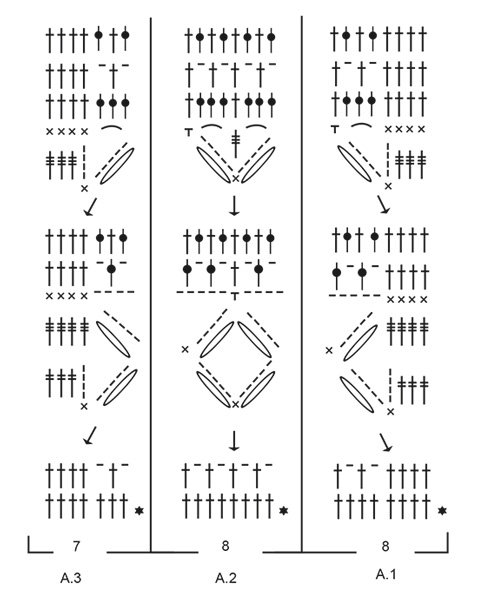 |
|||||||||||||||||||||||||||||||||||||
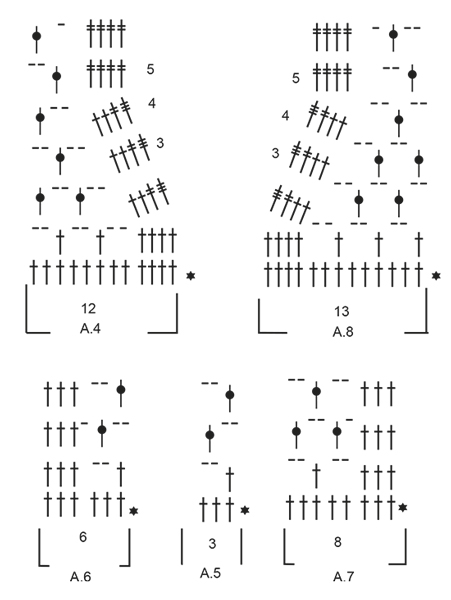 |
|||||||||||||||||||||||||||||||||||||
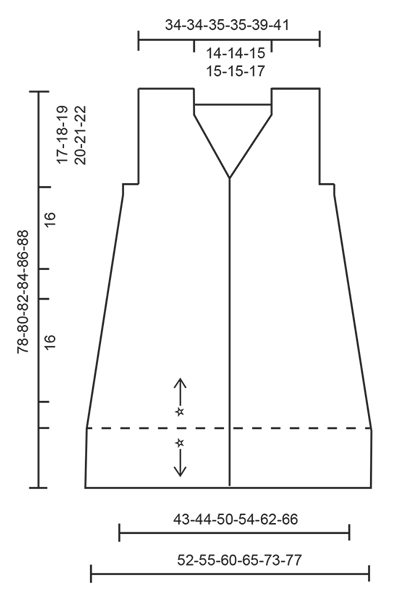 |
|||||||||||||||||||||||||||||||||||||
Have you finished this pattern?Tag your pictures with #dropspattern #summerblissvestvest or submit them to the #dropsfan gallery. Do you need help with this pattern?You'll find 11 tutorial videos, a Comments/Questions area and more by visiting the pattern on garnstudio.com. © 1982-2025 DROPS Design A/S. We reserve all rights. This document, including all its sub-sections, has copyrights. Read more about what you can do with our patterns at the bottom of each pattern on our site. |
|||||||||||||||||||||||||||||||||||||







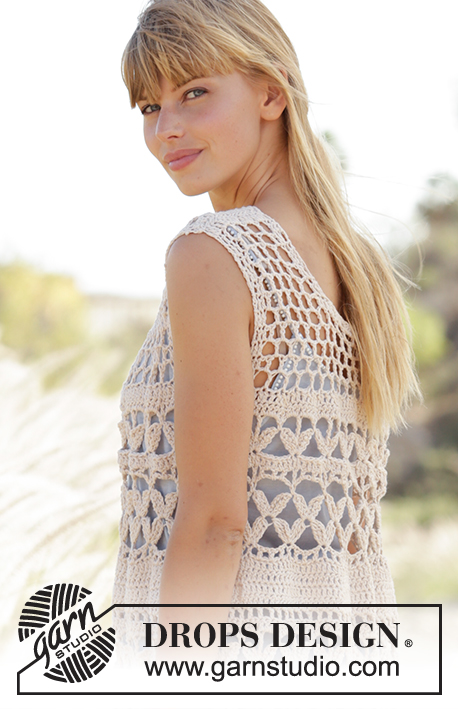


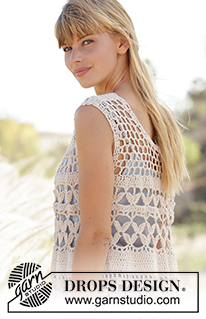





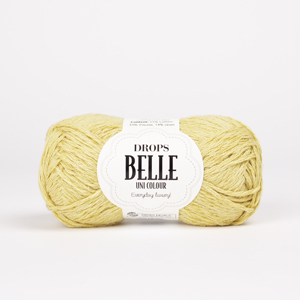


























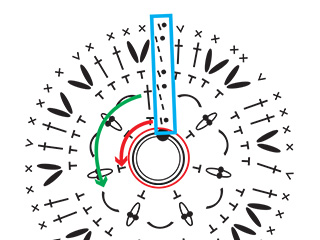







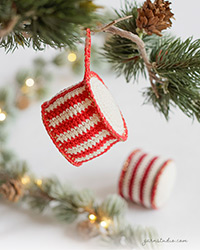





Post a comment to pattern DROPS 167-19
We would love to hear what you have to say about this pattern!
If you want to leave a question, please make sure you select the correct category in the form below, to speed up the answering process. Required fields are marked *.